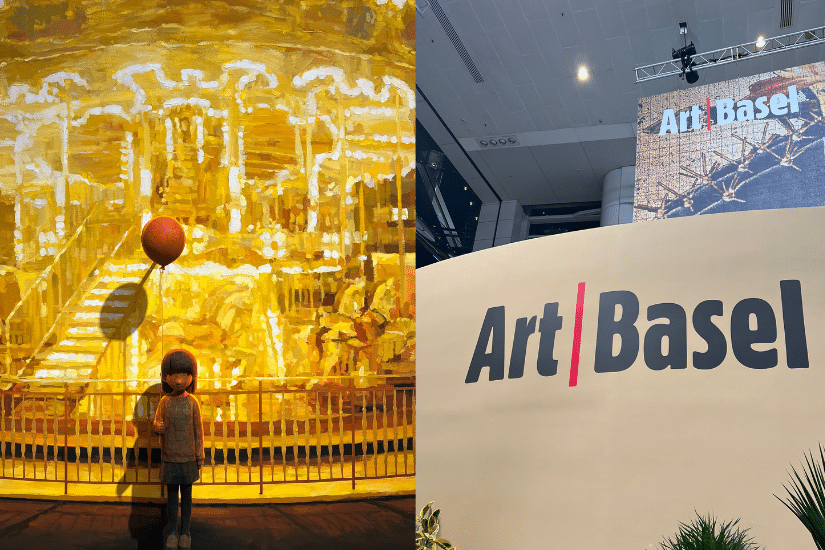The Art Basel Hong Kong Exhibition held in Asia is an annual event showcasing top galleries from Asia and around the world. This year, there are a total of 242 galleries participating from 40 countries and regions. Among these galleries, the Hong Kong exhibition presents a diverse artistic perspective, historical materials, and forward-looking works by renowned and emerging artists, providing audiences with a fresh art experience!
The exhibition is divided into five main sections: “Encounters,” “Galleries,” “Insights,” “Discoveries,” and “Kabinett.” The “Encounters” section, curated by Alexie Glass-Kantor, showcases large sculptures and installations by globally renowned artists, breaking the boundaries of traditional exhibition spaces and providing audiences with unique artistic experiences, as it has been a major highlight of the exhibition in the past. This year’s theme is “I am a part of all that I have met,” with 16 large installation pieces spread across two levels of the exhibition area.
Here are ten highlights collected by ZTYLEZ, bringing everyone together to savor the unique artworks of Art Basel!
Liang Huigui “Accidental Boundary”
(2020, 2022)
Exhibition Area: “Art Gathering Space” (Encounters)
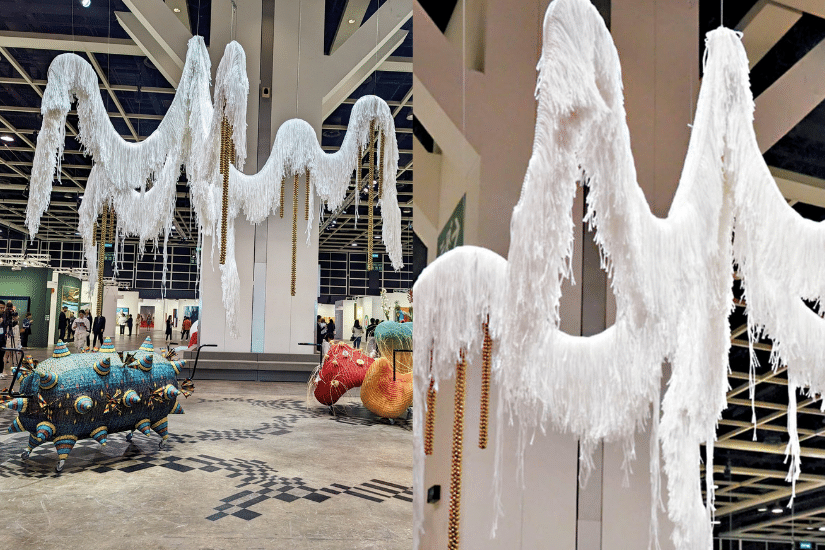
Artist Liang Huigui from Korea draws inspiration from traditional Filipino woven crafts. “The Realm of Chance” consists of three pieces: “The RandingIntermediates -Underbelly Alienage Duo”, “The Intermediate -Five- Legged Frosty Fecund Imoogi”, and “Sonic Cosmic Rope – Gold Dodecagon Straight Weave”.
The two installation works are two anthropomorphic rattan sculptures that combine the traditional Filipino weaving technique Binakol with 1960s Op Art, placed on a floor referencing the textile patterns of Binakol from the Philippines. The intersecting geometric shapes represent waves, a pattern that is traditional to the Cordillera region’s indigenous people, believed to symbolize protection from evil spirits; while the third hanging tassel rope, thick shiny bell installation piece, evokes a Korean folk tale of a brother and sister fleeing to the sky and turning into the sun and moon.
She weaves different time and space using weaving techniques, including mythological narratives, the fusion of spirituality and religion in ritual culture, evoking endless associations with myths, spirituality, and religious ritual culture. The bell string descends from the sky, symbolizing the world beyond the sky and potential, occasionally swaying, the sound reverberating in the space, attracting many onlookers to experience it.
Further Reading:
- 【March Art】Art Central 2024 Exhibition Guide!
- Feel the magic of Tadao Ando’s church architecture with wind, light, and water!
- Behind the Actress, Stories About Emma Stone!
2. Kaga Wen “Ukiyo-e”
(2022 – 2023)
Exhibition Area: “Encounters”
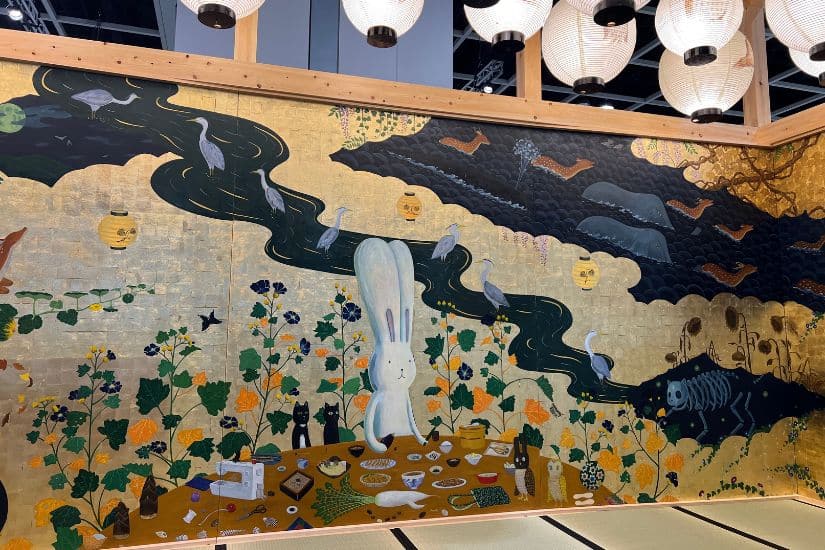
Artist Kaga Wen from Japan presents installation works in a theatrical form, drawing inspiration from small Kabuki theaters in the late Edo period. The composition, golden background, tatami flooring, and paper lanterns in the works all embody distinct characteristics of Japanese architectural style, connecting to the characteristics of the Kyoto Rinpa school in the 18th century and the mid-Edo period painter Ito Jakuchu active in Kyoto.
The rabbit spirit “Usacchi” in the work is inspired by the classic “pooka” from Irish folklore, representing another aspect of the artist’s self. Usacchi sits at a table in the center of a golden garden, surrounded by food and objects symbolizing the artist’s late mother, Kazuko. Usacchi picks up an eggplant and cucumber, symbols of the departed, and these small details showcase the artist’s cultural experiences in Japan and Europe. The intricate stage design also attracts many viewers’ attention!
3. Adira Suleiman “When You’ve Had Enough of Paradise”
(2024)
Exhibition Area: “Encounters”

Artist Adila Suleman from Karachi created an installation piece consisting of three hanging metal screens, with the patterns on the screens intricately connected by stainless steel sparrow-shaped metal accessories.
Each accessory is crafted using hand-embossed convex texture technique, inspired by the local folk art “chamakpatti” in Karachi and the exquisite silverware used by the Mughal royal family. The screen symbolizes the separation between this life and the afterlife, while the death of sparrows signifies a new beginning or entry into heaven. What is unique is that each sparrow is connected to another with a machine gun, representing the forced separation of people due to violence; and each bird sacrifices its life to the cycle of violence, becoming a mourning for these atrocities.
The screen and sparrows are meant to make people reflect on the disturbances of fear, war, and death in the present world, giving people a space for active reflection.
Lai Wei “Long Long Ago”
(2020 – 2024)
Exhibition Area: “Art Gathering Space” (Encounters)
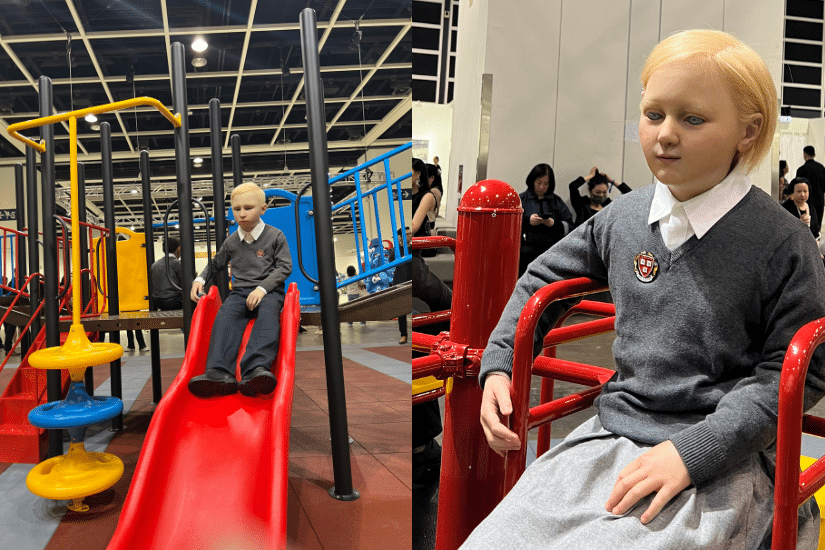
Artist Li Wei from China uses common playgrounds in Hong Kong as the creative space for this piece, imagining a group of world leaders reincarnated as seven-year-old children. Six hyper-realistic life-sized children are placed in various play facilities within the installation, creating a scene that is both familiar and eerily unsettling, making it one of the most striking works in the installation.
It is said that seven years old is the age when personality is fully formed, and becoming an adult is considered the beginning of degeneration. This group of seven-year-old children, dressed in neat school uniforms, inspired by hyper-realistic politicians, are placed in different poses in this specially created playground. Recently, these spaces have become places of supervision, vigilance, and loss of innocence, while also representing the blurred existence of world leaders, who may be playing for pleasure or plotting misconduct.
When people enter the amusement park, the sensors of the amusement facilities will be triggered, and people will begin to suffer from the “bird calls” attack, making them feel both absurd and surreal, as well as dilemma. The artist intends to use the calls of wild birds to urge people to reflect on the importance of global politics, which is not child’s play.
Mak2 “Copy within a Copy within a Copy within a Copy”
(2024)
Exhibition Area: “Encounters”
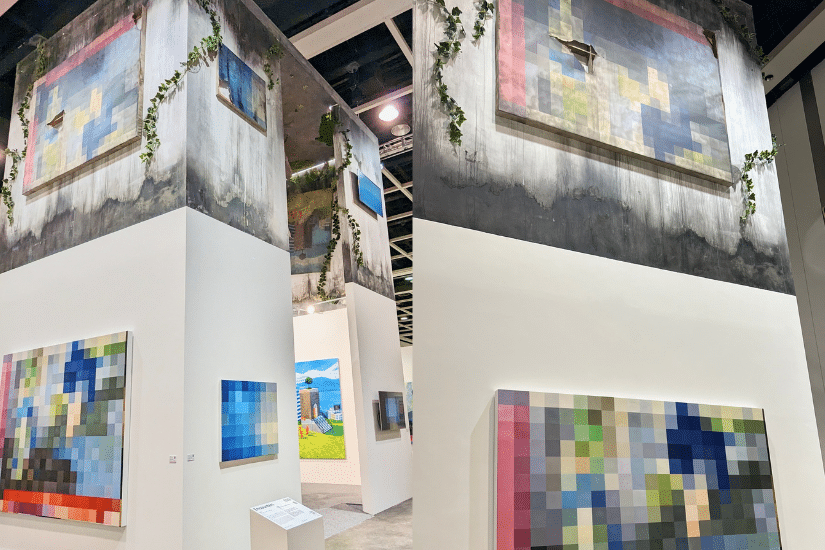
Artist Mak2 from Hong Kong replicated her work “Beautiful Home” next to the booth, creating an identical spatial layout with variations in orientation, mirroring, and mosaic forms, exploring the concepts of replication, evolution, and simulation, showcasing a satirical take on the culture of plagiarism.
The work is a triple mockery of plagiarism culture and one’s own work:
The first layer is the exhibition of the “Beautiful Home” triptych series by Mai Yingtong II, but the work is actually drawn by a painter from Taobao depicting scenes from The Sims game, creating a fictional love and evil that is difficult to distinguish between true and false;
Next to the booth, two duplicated booths are stacked on top of each other, with the lower part completely replicating Mai Yingtong II’s work at the Desa Gallery booth, but the triptych inside is simplified into a single painting, and the artwork is displayed in mosaic form;
The third layer is the mirrored version of the booth below, but this version of the booth is in a state of disrepair, full of mold, wild grass, and crooked paintings. People can only speculate whether this belongs to a dystopian art world 200 years later, or if it is simply the artist’s mockery of appearances.
6. Naminapu Maymuru-White “Larrakitj Forest”
(2024)
Exhibition Area: “Encounters”
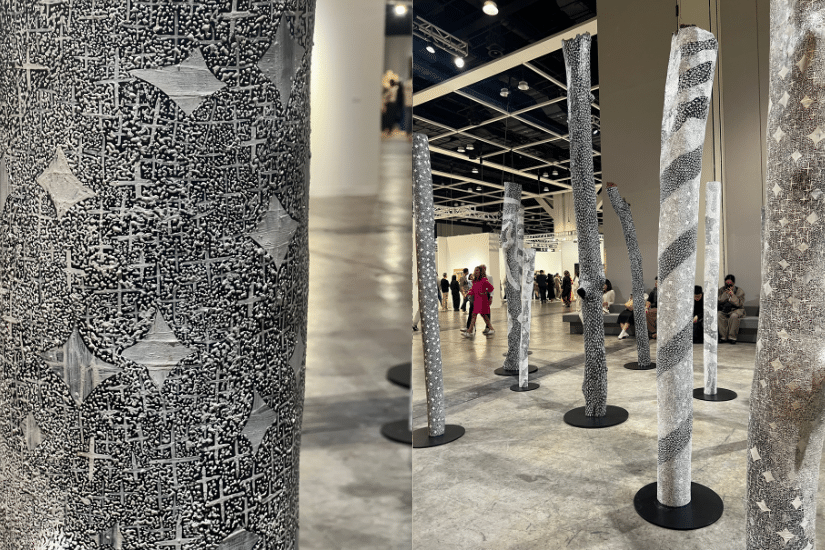
Artist Naminapu Maymuru-White from Australia uses a series of ovals to symbolize the funeral rituals, cosmology, and painting traditions of the Yolŋu indigenous community in northern Australia.
The Yolngu people are indigenous to the Arnhem Land region in the Northern Territory of Australia, and Yolngu art is an ongoing dialogue about abstraction and modes of expression, narrating the life meanings revered by the community and their intimate connection with the natural world. Artists depict the Milky Way on poles, conveying connections between all things: stars, water, sky, land, rivers, Larrakitj painting ceremonies, and the artists’ hands, proving the passage of time through ever-changing elements and the universe, affirming all that we encounter and the present moment.
7. Exhibition Area: Wong Hon Ming’s “Friendship First”
(2024)
Exhibition Area: “Encounters”
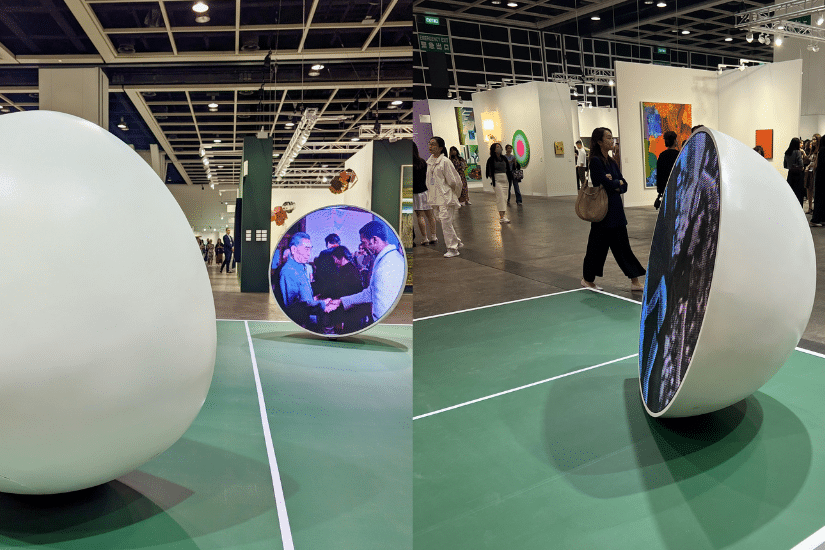
Singaporean artist Huang Hanming creates installations using sculptures: the floor is painted with a green pool table, two hemispheres serve as projection screens, playing documentary footage from the 1970s Sino-American “Ping Pong Diplomacy” era, reflecting the artist’s interest in the relationship between the two countries, embodying a dual narrative of popular culture and Cold War diplomacy.
The artist also collected images from publications such as “People’s Pictorial,” “People’s Daily,” “Time Magazine,” and “Life” magazine, documenting the 1971 Beijing Ping Pong Friendship Match, paving the way for the historic summit between China and the United States in 1972 during the peak of the Cold War.
8. Tsherin Sherpa “Stairways to Heaven”
(2023 – 2024)
Exhibition Area: “Encounters”
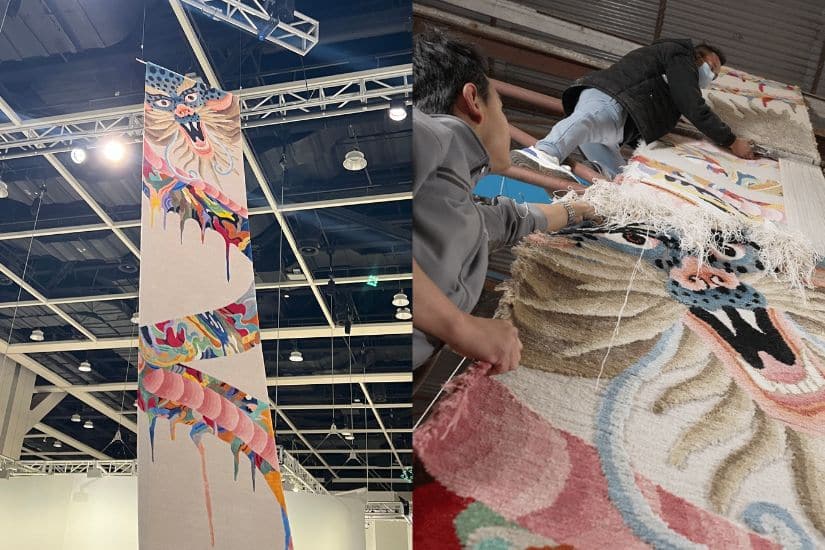
Artist Tsherin Sherpa from Nepal depicted a dragon that appears and disappears, spiraling and rising, on a ten-meter tapestry.
The artist draws inspiration from traditional esoteric totems, symbols, colors, and expressions, replacing the dragon’s scales with dynamic swirling patterns, reinterpreting one of the most common images in the making of Himalayan carpets from a contemporary perspective. The artist has used this pattern in multiple works, symbolizing the infinite power in this chaotic world we live in, and providing a potential interpretation of Nepalese material and traditional culture from an exotic perspective.
The work is also a collaboration with Mt. Refuge, a carpet workshop in Kathmandu, drawing on the long history of carpet making in Nepal to create this piece. For the artist, nothing exists independently, but rather everything is interdependent.
However, in the large-scale installation works of “Encounters,” there are still many works that showcase various skills and stories, including a new multimedia installation artwork created by Australian artist Daniel Boyd – “Doan,” exhibited inside the Hong Kong Pacific Place until April 7; don’t miss the free “Light Projection Live” screening event!
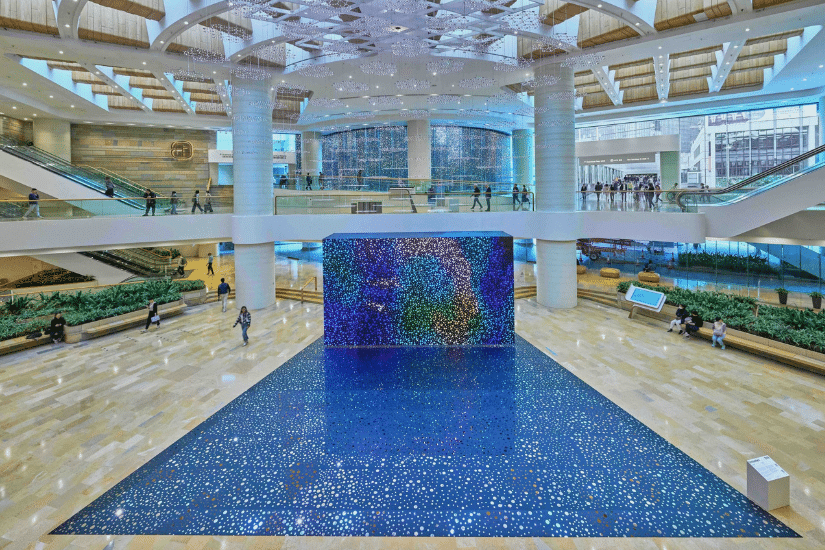
The atmosphere of Art Month, besides being able to participate in exhibitions on-site, is actually filled with different artistic vibes all over Hong Kong!

